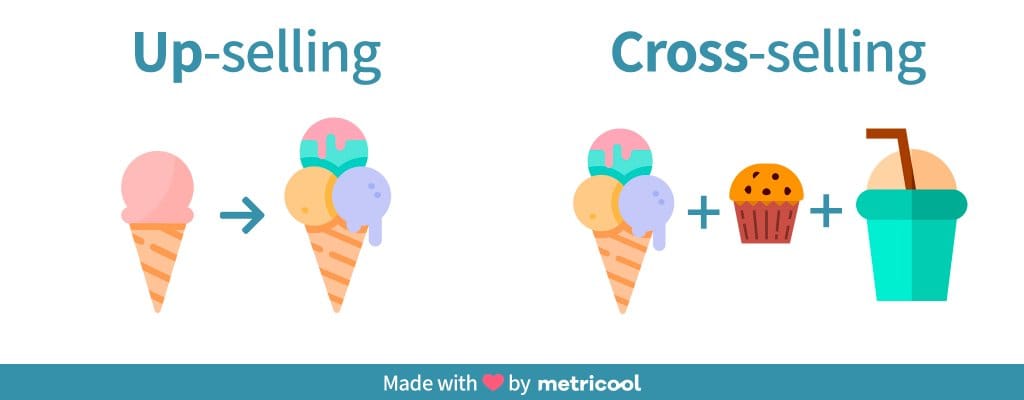Cross Selling vs. Upselling: What’s the Difference?

In today’s competitive business landscape, maximizing revenue from each customer interaction is crucial for success. Two powerful strategies that can help you achieve this are cross-selling and upselling. While these terms are often used interchangeably, they are distinct approaches with their own unique benefits and best practices.
Explore the differences between cross-selling and upselling, examine the key advantages of each, and gain actionable tips to help you implement these strategies effectively in your business. By the end of this guide, you’ll have a clear understanding of how to leverage cross-selling and upselling to boost your average order values, increase profit margins, and build stronger customer relationships.
What is Cross Selling?
Cross-selling is the practice of offering customers additional products or services that complement their initial purchase. The goal is to provide more value to the customer and increase the overall size of the sale.
Cross-selling is a powerful strategy that can benefit both the business and the customer. By identifying complementary products or services that align with the customer’s needs and interests, you can enhance their overall experience and meet their requirements more comprehensively.
Cross selling examples
Here are some common examples of effective cross-selling in action:
- Recommending a laptop case when a customer buys a new laptop. The case protects their investment and ensures they have a convenient way to transport it.
- Offering a warranty or protection plan when a customer buys an electronic device. These plans provide customers with peace of mind and additional coverage in case of accidental damage or malfunctions.
- Suggesting a coffee grinder or milk frother when a customer buys a new coffee maker. It allows the customer to get the most out of their coffee maker while increasing the overall sale value.
Benefits of cross selling
The key benefits of cross-selling include:
- Increased Revenue: Cross-selling allows you to generate more revenue from each customer transaction by encouraging them to purchase additional products or services.
- Improved Customer Satisfaction: Offering complementary products can enhance the customer’s experience and meet their needs more fully, leading to greater satisfaction and loyalty.
- Stronger Customer Relationships: Cross-selling demonstrates your understanding of the customer’s needs and preferences, helping to build a stronger, more trusting relationship.
Reduced Marketing Costs: It’s generally less expensive to sell to an existing customer than to acquire a new one, making cross-selling a cost-effective way to grow your business.

What is Up Selling?
Upselling is the practice of encouraging customers to purchase a more expensive, premium, or upgraded version of the product they initially wanted to buy. The goal is to increase the revenue from each individual sale by persuading the customer to spend more on a higher-value item.
This sales technique focuses on maximizing the value of each transaction. By presenting customers with an upgraded or premium option, you can entice them to invest more in a product or service that better meets their needs or desires.
Up selling examples
Here are some common examples of effective upselling in action:
- Recommending a customer a higher-end model of a smartphone with more features. By highlighting the benefits of the premium model, you can persuade the customer to spend more for a product that better meets their needs.
- Suggesting a premium subscription or ad-free version when a customer is signing up for a free online service or app.
- Offering a premium paint color, upgraded trim, or additional accessories when a customer is purchasing a new car. These upgrades can enhance the vehicle’s appearance, comfort, or functionality.
Benefits of up selling
The key benefits of upselling include:
- Higher Average Order Value: Upselling encourages customers to spend more on each purchase, leading to a higher average order value and increased revenue.
- Increased Profit Margins: Higher-end products often have better profit margins than base models, making upselling a more profitable strategy for the business.
- Showcased Product Offerings: Upselling allows you to highlight the full range of products and services you offer, demonstrating your value and expertise to the customer.
- Improved Customer Satisfaction: Upselling can provide customers with a better product or service that more closely meets their needs and preferences, leading to greater satisfaction and loyalty.
How to Cross Sell Effectively
Effective cross-selling requires a deep understanding of your customers and product offerings. The key is to identify complementary products that can add value to the customer’s initial purchase. Some tips for effective cross-selling include:
- Map Complementary Products: Analyze customer purchase history to identify common product pairings and create a “map” of complementary options for your sales team.
- Time Cross-Sells Appropriately: Cross-sell offers are often most effective at the end of the sales process, when the customer has already committed to a purchase.
- Ask Probing Questions: Use a consultative sales approach to uncover the customer’s needs and pain points, then recommend relevant complementary products.
- Demonstrate Value: Use testimonials, case studies, and ROI calculations to show customers how additional products can benefit them.
How to Upsell Effectively
Upselling is often easier than cross-selling, as the customer has already expressed interest in a particular product. The goal is to encourage them to purchase a higher-end, premium version. Effective upselling strategies include:
- Highlight Product Differences: Emphasize the features and benefits that distinguish the upgraded product from the base model.
- Time Upsells Appropriately: Introduce upsell offers when the customer has narrowed their focus to a specific product.
- Leverage Customer Data: Use customer segmentation and behavior analytics to identify the best upsell opportunities for each buyer persona.
- Demonstrate Value: Prove the upgraded product’s value through testimonials, demonstrations, and ROI calculations.
How Cross-Selling and Upselling Work Together – Example
Cross-selling and upselling are often used together as complementary strategies:
- Cross-Selling: Offer the customer additional related products to increase the overall value of the purchase.
- Upselling: Encourage the customer to upgrade to a higher-end version of the product they initially wanted to buy.
Using cross-selling and upselling together can be a powerful strategy. First, cross-sell complementary products to increase the overall value of the purchase. Then, upsell the customer to a premium version of the primary product. This combination can maximize revenue from each customer interaction.
💡 For example: A customer wants to purchase a new smartphone. They’ve narrowed it down to the “SmartFone 12” model. The premium “SmartFone 12 Pro”, however, comes with a better battery life, camera, and screen resolution. The customer is particularly interested in a good camera for their up-and-coming travel blog and wants a long battery life because they travel to remote locations.
The customer decides to go with the “SmartFone 12 Pro” model (upselling) because of the camera and battery. After, since they travel so much, they also purchase an extended warranty, protective phone case, and a screen protector (cross selling).
The key is to deeply understand your customers and products, then time your cross-sell and upsell offers appropriately throughout the sales process. By providing genuine value and demonstrating the benefits, you can increase average order values and strengthen customer relationships.

